前言:
我们都知道,SpringBoot启动会默认加载很多xxxAutoConfiguration类(自动配置类)
其中SpringMVC的大都数功能都集中在WebMvcAutoConfiguration类中,根据条件ConditionalOnxxx注册类对象;WebMvcAutoConfiguration满足以下ConditionalOnxxx条件,类是生效的,并把其对象注册到容器中。

那WebMvcAutoConfiguration生效给容器中配置了什么呢?
WebMvcAutoConfigurationAdapter静态内部类
一.配置文件前缀
我们来看WebMvcAutoConfiguration类中的WebMvcAutoConfigurationAdapter静态内部类:
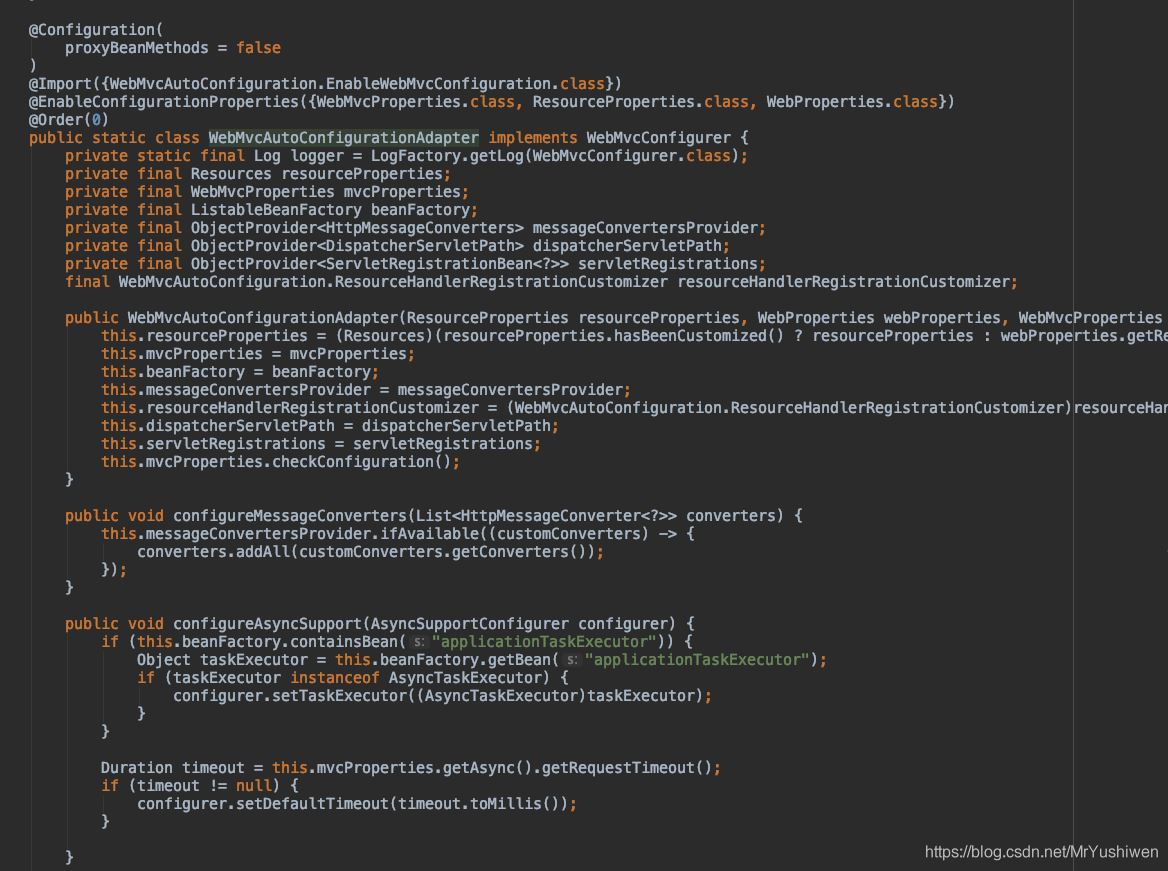
这是一个配置类,配置文件的属性和xxx进行了绑定。
再看@EnableConfigurationProperties({WebMvcProperties.class, ResourceProperties.class, WebProperties.class})
我们来看当中的WebMvcProperties、ResourceProperties和WebProperties的字节码文件
分别点进这三个类的字节码文件中:
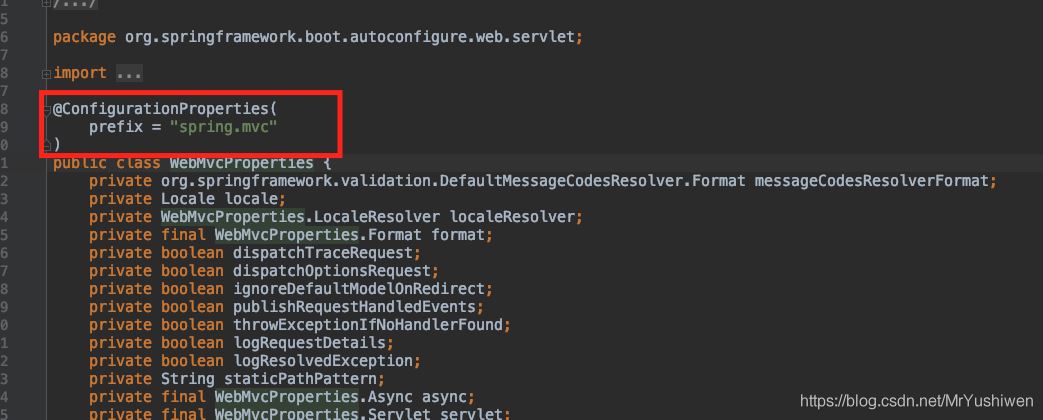
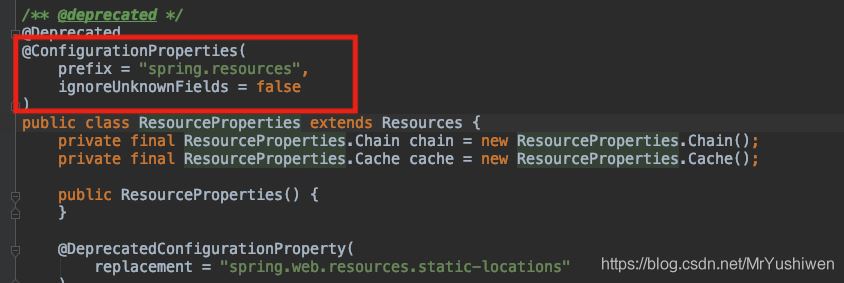

可以看到WebMvcProperties它是与配置文件前缀spring.mvc相关联的。
ResourceProperties它是与配置文件前缀spring.resources相关联。
WebProperties它是与配置文件前缀spring.web相关联。
二.只有一个有参构造器
WebMvcAutoConfigurationAdapter静态内部配置类只有一个有参数的构造器,那它会带来什么特性呢?
它的有参构造器中所有参数的值都会从容器中确定
public WebMvcAutoConfigurationAdapter(ResourceProperties resourceProperties, WebProperties webProperties, WebMvcProperties mvcProperties, ListableBeanFactory beanFactory, ObjectProvider<HttpMessageConverters> messageConvertersProvider, ObjectProvider<WebMvcAutoConfiguration.ResourceHandlerRegistrationCustomizer> resourceHandlerRegistrationCustomizerProvider, ObjectProvider<DispatcherServletPath> dispatcherServletPath, ObjectProvider<ServletRegistrationBean<?>> servletRegistrations) {
this.resourceProperties = (Resources)(resourceProperties.hasBeenCustomized() ? resourceProperties : webProperties.getResources());
this.mvcProperties = mvcProperties;
this.beanFactory = beanFactory;
this.messageConvertersProvider = messageConvertersProvider;
this.resourceHandlerRegistrationCustomizer = (WebMvcAutoConfiguration.ResourceHandlerRegistrationCustomizer)resourceHandlerRegistrationCustomizerProvider.getIfAvailable();
this.dispatcherServletPath = dispatcherServletPath;
this.servletRegistrations = servletRegistrations;
this.mvcProperties.checkConfiguration();
}
我们来看下它的参数:
- 第一个参数是ResourceProperties resourceProperties 就是我们上面提到的@EnableConfigurationProperties({WebMvcProperties.class, ResourceProperties.class, WebProperties.class})中注册开启的第二个类,获取和spring.resources绑定的所有的值的对象
- 第二个参数是WebProperties webProperties 就是我们上面提到的@EnableConfigurationProperties({WebMvcProperties.class, ResourceProperties.class, WebProperties.class})中注册开启的第三个类,获取和spring.web绑定的所有的值的对象
- 第三个参数是WebMvcProperties mvcProperties 就是我们上面提到的@EnableConfigurationProperties({WebMvcProperties.class, ResourceProperties.class, WebProperties.class})中注册开启的第一个类,获取和spring.mvc绑定的所有的值的对象
- 第四个参数是ListableBeanFactory beanFactory ,这个是Spring的beanFactory,也就是我们的容器。
- 第五个参数是ObjectProvider messageConvertersProvider,找到所有的HttpMessageConverters
- 第六个参数是ObjectProvider<WebMvcAutoConfiguration.ResourceHandlerRegistrationCustomizer> resourceHandlerRegistrationCustomizerProvider,找到资源处理器的自定义器
- 第七个参数是ObjectProvider dispatcherServletPath,相当与找dispatcherServlet能处理的路径
- 第八个参数是ObjectProvider<ServletRegistrationBean<?>> servletRegistrations ,给应用注册原生的Servlet、Filter等等
构造器初始化后,我们已经把所有的东西从容器中拿到了
三.源码分析addResourceHandlers方法
所有的资源处理默认规则都在addResourceHandlers方法中,如下:
public void addResourceHandlers(ResourceHandlerRegistry registry) {
if (!this.resourceProperties.isAddMappings()) {
logger.debug("Default resource handling disabled");
} else {
Duration cachePeriod = this.resourceProperties.getCache().getPeriod();
CacheControl cacheControl = this.resourceProperties.getCache().getCachecontrol().toHttpCacheControl();
if (!registry.hasMappingForPattern("/webjars/**")) {
this.customizeResourceHandlerRegistration(registry.addResourceHandler(new String[]{"/webjars/**"}).addResourceLocations(new String[]{"classpath:/META-INF/resources/webjars/"}).setCachePeriod(this.getSeconds(cachePeriod)).setCacheControl(cacheControl).setUseLastModified(this.resourceProperties.getCache().isUseLastModified()));
}
String staticPathPattern = this.mvcProperties.getStaticPathPattern();
if (!registry.hasMappingForPattern(staticPathPattern)) {
this.customizeResourceHandlerRegistration(registry.addResourceHandler(new String[]{staticPathPattern}).addResourceLocations(WebMvcAutoConfiguration.getResourceLocations(this.resourceProperties.getStaticLocations())).setCachePeriod(this.getSeconds(cachePeriod)).setCacheControl(cacheControl).setUseLastModified(this.resourceProperties.getCache().isUseLastModified()));
}
}
}
1.禁用掉静态资源的路径映射
我们打上断点看它的默认规则是怎么起作用的,首先调用resourcePropertoes的isAddMappings()方法:

判断this.resourcePropertoes的isAddMappings()方法是不是不为true,
- this.resourcePropertoes我们刚才在2中讲构造器时讲到的ResourceProperties resourceProperties 就是我们上面提到的@EnableConfigurationProperties({WebMvcProperties.class, ResourceProperties.class, WebProperties.class})中注册开启的第二个类,获取和spring.resources绑定的所有的值的对象
- isAddMappings()方法返回的是this.addMappings的值,如下:

也就是说我们可以通过设置addMappings的值是false还是true来让这个if语句是否执行
我们可以在配置文件中进行设置:
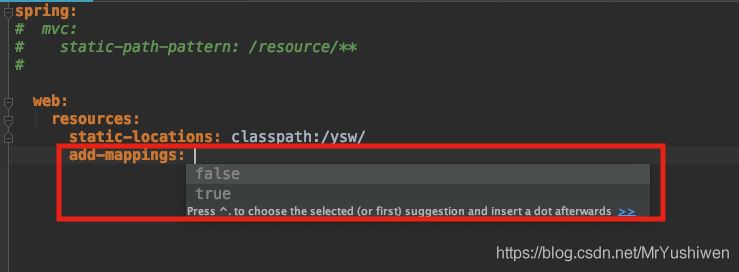
默认它是true,如果是false,那么他就进入if语句中,执行logger.debug("Default resource handling disabled");后结束该方法,else中的所有配置都不生效

else中的什么配置/webjars/**去哪找等等一些规则都不生效了。
也就是说我们通过设置add-mappings: false 来禁用掉了静态资源的路径映射。
禁用后所有的静态资源都访问不了了。
addMappings的值如果是true,那么他就不会进入if语句中,而是进入到else语句中,那么else语句的内容都得到了执行,下面我们看它是怎么配置静态资规则的。
2.源码分析webjars的底层规则
进入到else语句中,第一行是Duration cachePeriod = this.resourceProperties.getCache().getPeriod();,它从resourceProperties里面获取到关于缓存的相关值。我们在yaml配置文件中配置一下这个值:
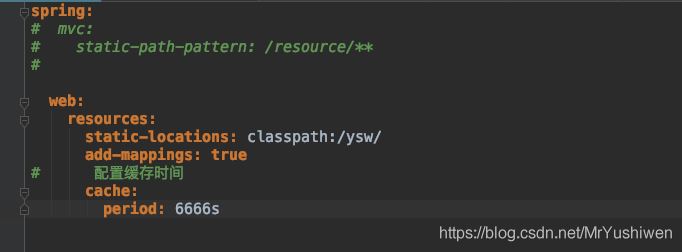
缓存时间是以秒为单位的,如下:

意思就是我们所有的静态资源默认可以缓存存储多少秒
我们debug接着往下走,看到cachePeriod中取到了刚刚yaml中设置的6666,以后我们的浏览器就会把我们的静态资源缓存6666秒:
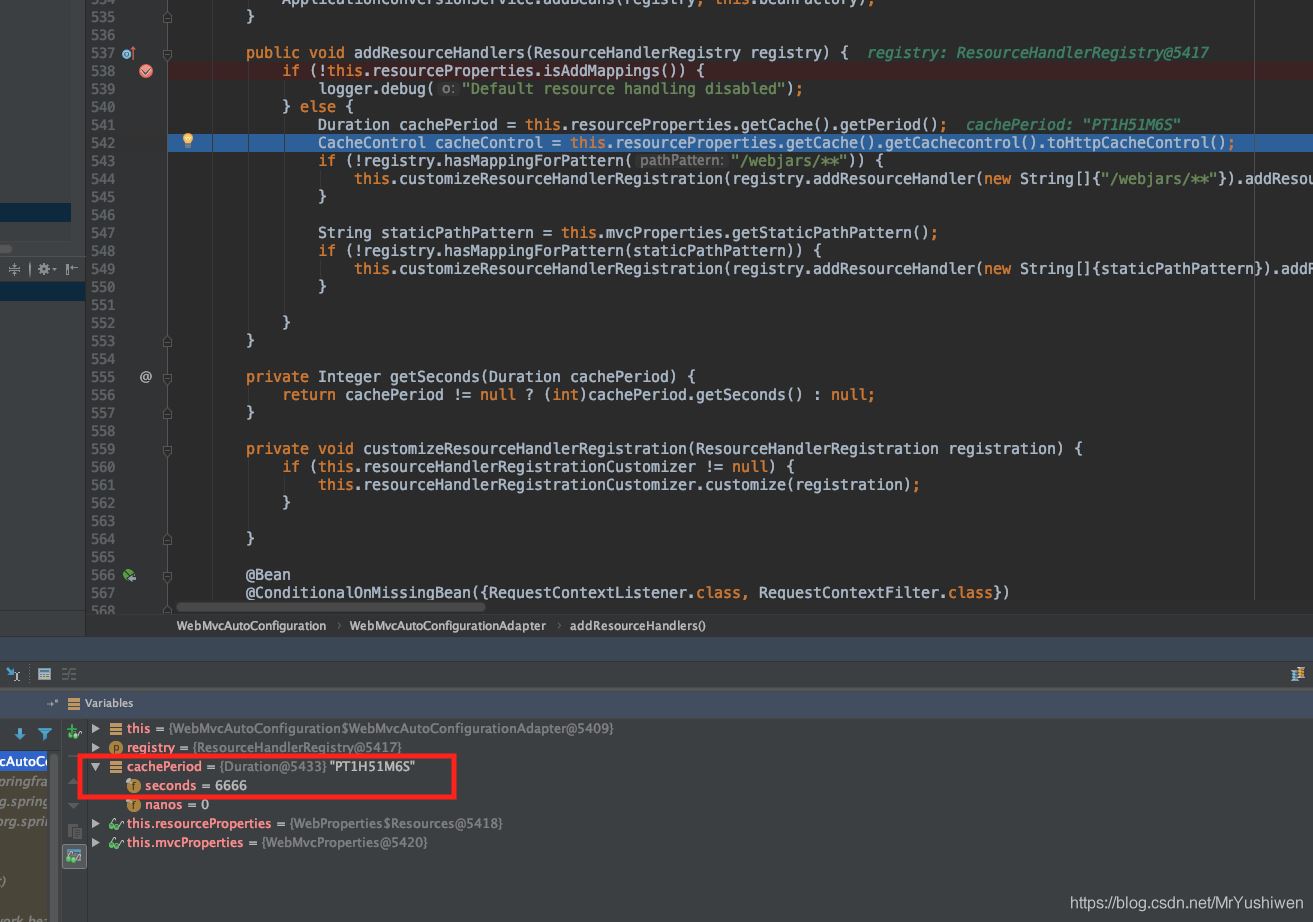
debug接着往下走,我们到了注册"/webjars/**"这个规则的地方:
if (!registry.hasMappingForPattern("/webjars/**")) {
this.customizeResourceHandlerRegistration(registry.addResourceHandler(new String[]{"/webjars/**"}).addResourceLocations(new String[]{"classpath:/META-INF/resources/webjars/"}).setCachePeriod(this.getSeconds(cachePeriod)).setCacheControl(cacheControl).setUseLastModified(this.resourceProperties.getCache().isUseLastModified()));
}
也就是说我们访问/webjars下面的所有请求都找我们的classpath:/META-INF/resources/webjars/路径,其中还设置了其静态资源的缓存时间为6666秒。
拿jquery来举例,为什么我们导入jquery之后,我们只需要访问/webjars/jquery/3.5.1/jquery.js就能够访问到/META-INF/resources/webjars/jquery/3.5.1/jquery.js,如下:
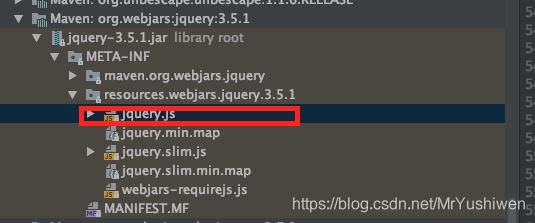
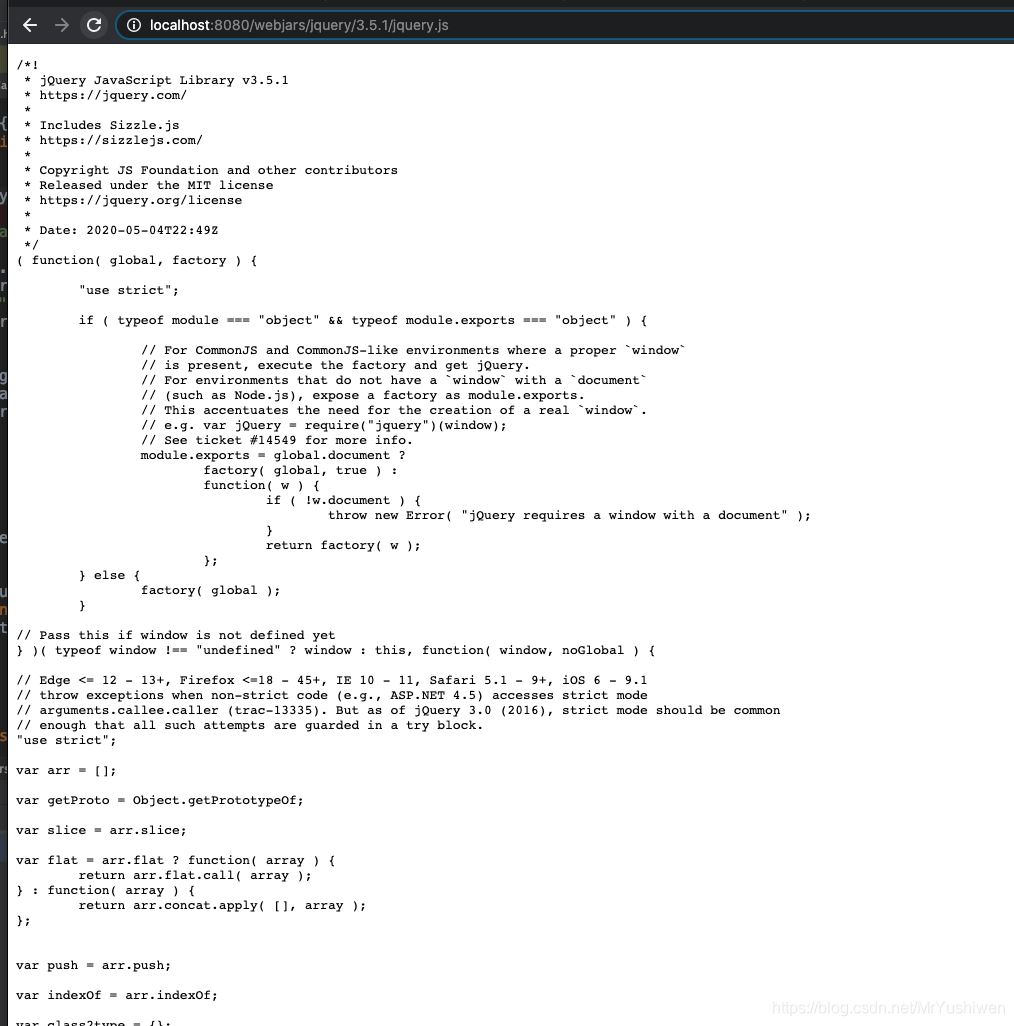
其缓存时间也可以在浏览器中看到为6666秒:

3.源码分析默认静态资源路径的底层规则
我们在else里面接着往下debug,接着我们用mvcProperties属性调用其getStaticPathPattern()方法

- this.mvcProperties我们刚才在2中讲构造器时讲到的WebMvcProperties mvcProperties 就是我们上面提到的@EnableConfigurationProperties({WebMvcProperties.class, ResourceProperties.class, WebProperties.class})中注册开启的第一个类,获取和spring.mvc绑定的所有的值的对象
- getStaticPathPattern()方法,这个方法返回的是staticPathPattern的值,如下:

staticPathPattern的这个值可以在我们的配置文件中进行配置,它的默认值是/**,如下:

我们也可以把前缀配置成/resource/**,如下:

debug接着往下走,接下来调用的方法与上面的webjars是一样的方法,只不过参数有所不同:

接下来我们具体看代码:
String staticPathPattern = this.mvcProperties.getStaticPathPattern();
if (!registry.hasMappingForPattern(staticPathPattern)) {
this.customizeResourceHandlerRegistration(registry.addResourceHandler(new String[]{staticPathPattern}).addResourceLocations(WebMvcAutoConfiguration.getResourceLocations(this.resourceProperties.getStaticLocations())).setCachePeriod(this.getSeconds(cachePeriod)).setCacheControl(cacheControl).setUseLastModified(this.resourceProperties.getCache().isUseLastModified()));
}
把刚刚的前缀staticPathPattern得到后作为实参传入hasMappingForPattern方法中,注册前缀这个规则,刚刚我们在yaml中设置了前缀为/resource/**,也就是说我们访问/resource/**下面的所有请求都找我们的this.resourceProperties.getStaticLocations() 路径,其中也设置了其静态资源的缓存时间为6666秒。
this.resourceProperties.getStaticLocations()方法返回的值是什么呢?我们点进去看一下:

this.resourceProperties.getStaticLocations()返回的是this.staticLocations,这个staticLocations定义如下:

可以看到它是一个字符串数组,在无参构造器中进行了初始化,初始化的值是CLASSPATH_RESOURCE_LOCATIONS常量,常量的值为:
“classpath:/META-INF/resources/”, “classpath:/resources/”, “classpath:/static/”, "classpath:/public/“。这就解释了静态资源路径为什么默认为这四个路径。
看到这里你有没有恍然大悟,
到此这篇关于SpringBoot静态资源配置原理(源码分析)的文章就介绍到这了,更多相关SpringBoot静态资源配置内容请搜索自学编程网以前的文章或继续浏览下面的相关文章希望大家以后多多支持自学编程网!

- 本文固定链接: https://47.98.125.4/post/204066/
- 转载请注明:必须在正文中标注并保留原文链接
- QQ群: PHP高手阵营官方总群(344148542)
- QQ群: Yii2.0开发(304864863)
